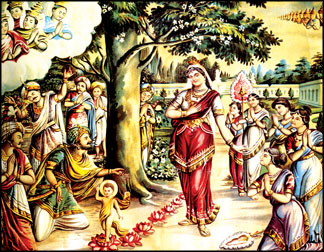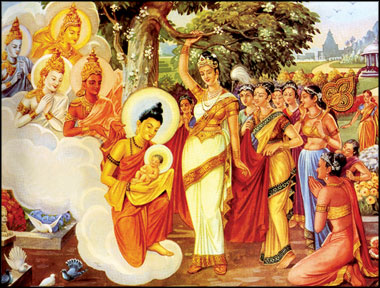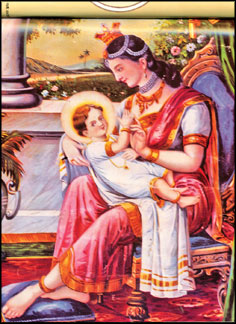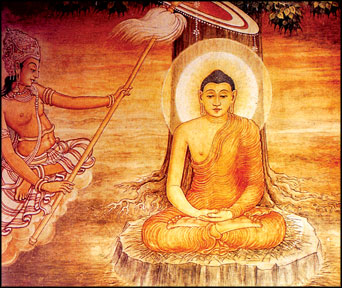Fascinating murals
By Shireen Senadhira
 Vesak time was just over and the all the temples were spruced up. I
visited the Gothami Vihara in Borella area, mainly to admire the famous
murals in the temple's shrine room. This particular temple was built by
Apolonia de Soysa Pieris, mother of Sir James Pieris. This temple would
have been one among the others in our country but for the fact that it
contained special murals. Vesak time was just over and the all the temples were spruced up. I
visited the Gothami Vihara in Borella area, mainly to admire the famous
murals in the temple's shrine room. This particular temple was built by
Apolonia de Soysa Pieris, mother of Sir James Pieris. This temple would
have been one among the others in our country but for the fact that it
contained special murals.
This vihara was established in 1900. Then, in 1939, George Keyt, the
well known artist was invited to paint the walls in the shrine room
where the statues are. He was asked to paint episodes that depicted the
life of Buddha and so he did. Thus, this temple became special as the
other temples mostly have murals of the Jataka stories and paintings of
hell.
George keyt was one of our foremost artists when he took over this
task. Keyt took only one year to paint all the walls of the shrine room.
He had not hitherto undertaken this type of work. Manjusri, a priest
turned artist, assisted Keyt and his stylized paintings adorn the
entrance sandalwood door of the shrine room. These two artists belonged
to the renowned Group of '43, of Sri Lanka who were none other than the
avant garde artists of Sri Lanka who exhibited here and abroad. Though
there were and are many modern artists, no other group similar to this
was ever formed in Sri Lanka.
At a time when western educated elite of art had looked in askance at
the value of Sri Lankan painting tradition, George Keyt was successful
in combining tradition with modernity in his paintings. By creating the
Gothami Vihara murals, he added a new step to the Sri Lankan painting
traditions.
It was Andrew Bayd, an architect at that time who prepared the walls
of the shrine room to help Keyt paint on them. Keyt, when he painted
episodes from the life of Buddha on the walls, he did it with a
flourish. Keyt painted the murals so as to unfold the life of Buddha
like reading a story book. The effect was more so as the paintings are
drawn below eye level.
He painted his well known figure painting depicting, inviting the
Gods, Queen Mahamaya 's dream , wedding of Siddhartha, birth of Rahula
and the Buddha's first sermon on these walls. He also linked the
drawings from one to another and one can easily understand the story
painted. The biggest paintings are Buddha visiting Kimbulvathpura and
his first sermon. It is said that Keyt drew all the pictures without any
prior practice. Since this was a new style, many praised his creativity
and ability. The then incumbent prelate however, wanted these dark brown
murals to be coloured. Then by using a method known as 'burnt Sienna'
the murals were coloured.
 |
|
Birth of Prince
Siddhartha |
Murals have a long history. The painting of murals is time
immemorial. Mural painting has its primeval instincts of people to
decorate their surroundings and to use wall surfaces as a form of
expressing ideas, emotion and beliefs. In the ancient murals of the ice
age and the protodynastic Egyptian frescoes, symbols and
representational images have been spread freely and indiscriminately
across walls, ceilings and floors. The same concept is displayed in the
graffiti paintings of the present.
Later, in more disciplined attempts to symbolize the importance and
ideas, buildings, through interior décor have designed murals in
specific surface areas. This was done taking care of scale, style mood
of the interior, with consideration to light sources, spectator levels
of sight and way of approach as well as the emotive relationship of the
viewer to the painted images.
It is said that origins of the primeval murals can be discerned dimly
in the caves of the nomadic hunter artists of the Paleolithic Age (25000
- 10000 BC) and in the lake dwellings and agricultural settlements of
their Neolithic successors (10000 - 4000 BC).
Egypt is one of the chief storehouses of ancient murals, as of all
the arts. These testify clearly to the antiquity of Egyptian
civilization and the earliest paintings more than 4000 years before our
era and are also the cleverest, both in drawing and execution. In later
times, Egyptian art influenced the great Persian empire and throughout
the valley of Euphrates. This same influence affected the early art of
Greece, It is said that only in the middle of the 5th century BC, that
the further development and perfecting of Grecian art could obliterate
the old traces of Egyptian mannerism .
Some of the well known murals of the world are: Egyptian frescoes -
tomb of Nebamum, Thebes, (in the British Museum) (1450 BC) , Ajanta cave
murals, India ( 7th C), Sistine Chapel paintings, ceiling frescoes,
Creation of Adam, (early 16th C)and the magnificent frescoes of
Kaisersaal Residenz, Wurzburg, West Germany, (18th C).
The European churches and palaces are enriched with splendid murals
and one looks at them in wonderment. Coming across to the south western
coast of India, in Kerala, prehistoric paintings have been found in the
Anjanad valley of the Idukki district.
It has been presumed by archeologists that these paintings belong to
a different period from the upper Paleolithic period to early historic
period. The roots of the Kerala murals have been traced to the more
ancient Dravidian art. In India, the state of Kerala holds the second
place in having the largest collection of archeologically important
mural sites, the first being Rajasthan. Our own frescoes in Sigiriya
Rock, in central Sri Lanka also stand alongside these famous murals. It
is breathtaking to know and your good fortune to see some of the 492
decorated caves that are preserved to the present day.
 |
|
Prince Siddhartha and
Mahamaya |
They are the Mogao caves temples near the town of Dunhuang, at the
edge of the Gobi desert in north-western China. These caves are filled
with the most extensive and exquisite collections of Buddha paintings
and sculptures in the world. Every surface of the walls and ceilings are
filled with paintings. Row upon row of miniature images of the Buddha,
subtly varying in colour and dress adorn virtually every cave.
The site is popularly known as the 'Caves of thousand Buddhas.' An
interesting fact is that Dunhuang town lay at a crucial junction of the
Silk Road, the ancient braid of caravan tracks stretching for more than
7000 kilometers from China to the Mediterranean. Thus, it is said that
by the 4th century, the Silk Road brought Dunhuang town commercial
prosperity and a growing Buddhist community.
Much later in the 20th century, another aspect of the murals was
manifested. It was the political murals. In Mexico, after a prolonged
civil war and people's revolution, the Mexican Mural Movement was born.
Thus, the 1930s brought a new prominence to murals as a social and
political tool in Mexico. In 1948 the Colombian government hosted a Pan
American conference to establish the Marshal Plan for the Americas and
the Colombian government commissioned and a mural was painted in the
Colombian congress building to commemorate the event. Almost 2000 murals
have been documented in Northern Ireland since the 1970s and some depict
notable political topics.
The famous Berlin Wall between East and West Germany had murals
painted only on the Western side of the wall from the 80s until the fall
of the Wall in 1989. This wall became the 'longest canvas' of the world
for artists to give vent to their ideas and depict them. After the fall
of the Berlin Wall, the Eastern side of the Wall too became also a
popular 'canvas' for many mural and graffiti artists.
In Sri Lanka, one of our prominent muralists is Senaka Senanayake. A
child prodigy in art is now an internationally celebrated artist. His
murals capture the vibrant hues, radiant moods and the sparkling
effervescence of the tropics. His works are immensely popular across the
globe and are seen in prestigious buildings. To name a couple of
buildings, they are the white House in Washington and the UN
headquarters in New York. His art celebrates the country's flora and
fauna. He has the gift of lifting up one's spirits with his murals in
the present gloomy scenario of life. It is interesting to note that the
circular style adopted in Senaka's paintings, portrays three reasons .
They are, to create movement, dimension and the continuity of life and
this is greatly thought evoking too.
Lucky Senanayake, a Sri Lankan, is a well known muralist too among
his other talents. His marvelous renderings of capturing the spirit of
the foliage as much as the place that harbors them are portrayed in his
large murals. The details of branches, patterns of leaves and the
shadows they cast in the sun and shade are all reflected in his single
colour murals. Some of them can be seen in the big building and hotels
here and have not been paralleled.
Murals today are painted in a variety of ways, using oil or water
based media. The styles can be traditional, modern and abstract. The
murals too have experienced a renaissance in buildings of Europe. The
best well known method that was used for a long time was the water
soluble paints with a damp lime wash. A rapid use of the resulting
mixture can cover a large surface area.
The colours lighten as they dry. Another method is that the paint
pigment mixed with water is painted on a thin layer of fresh lime mortar
or plaster. The pigment is then absorbed by the wet plaster and after a
number of hours, the plaster dries and reacts with the air; it is this
chemical reaction which fixes the pigment particles in the plaster.
After this, the painting stays for a long time up to centuries in fresh
and brilliant colours. Tempera painting is one of the oldest known
methods in mural painting.
 |
|
Enlightenment |
In tempera, the pigments are mixed with a binding albuminous medium
such as egg yolk or egg white and diluted with water. The famous
Sigiriya frescoes on the 'mirror wall' were painted in this manner.
There is another method, in which a nearly dry plaster is painted so
that the pigment only penetrates slightly into the plaster. This method
was used by Michelangelo.
Murals are important in that they bring art into the public sphere.
For artists, their work gets a wide audience who otherwise might not set
foot in an art gallery. A city benefits by the beauty of a work of art.
Murals can have a dramatic impact whether consciously or subconsciously
on the attitudes of the passers by, when they are added to areas where
people live and work. It can also be argued that the presence of large,
public murals can add aesthetic improvement to the daily lives of
residents.
Public commissions of murals in schools, hospitals and retirement
homes can achieve a pleasing and welcoming atmosphere in these caring
institutions.
Murals are dedicated to healing. When communities are faced with
disaster, like in Unawatuna, south of Sri Lanka, after the December 2004
Tsunami, somewhat later, people from all over the country and all walks
of life got together to paint an underwater scene mural on a wall
erected by the side of the beach. The wall was 200 metre long and 6 feet
tall. It provided a catalyst for discussion, people needed and outlet
and many ideas were discussed. Observers stopped and spoke candidly to
the painters and to each other, describing both what they thought the
mural meant and what they were feeling and experienced as front liner
workers in a disaster. Some tsunami affected people in the vicinity came
forwards and talked to the painters and others. Some of their heartfelt
tales and insights were infused in the mural with a kind of poetic
expression.
In Bolivia, in 1997, young drug addicts and alcoholics were brought
from the rehabilitating centers and they contributed to a mural painting
session together with the help of 200 high school students. The team
effort produced a vast mural portraying the harsh realities of drug
addiction and alcoholism in Bolivia. Between brush strokes, the former
drug addicts came out with comments such as: "I am so glad to have this
opportunity to warn young people like me about getting hooked on drugs
and coming to a horrible end."
"Once you start taking drugs you are trapped in a vicious hold. I
don't want that to happen to others. So, that's why I'm painting this
message."
The beauty of this work was that the message was being led, was being
driven by those who were most affected, by those touched and those who
were recuperating from the problem.
I visited a hospital some time ago to look at its murals. At that
time, the sick but able children were painting a new ward wall. As I
watched happily but in amazement how the children were applying paint
and chuckling and laughing and singing, I noticed that there were adults
but they were quiet in supervising. A sick little boy in a wheel chair
was placing his palms on two trays of paint and applying them this way
and that on the wall. I went behind him and said gently,
"I would love to do that too."
"Why don't you?" he replied and turned his twisted body in the chair
holding his painted palms high and he had paint on his nose too. He gave
me such a warm grin that I wanted to hug him but instead I hugged the
image of him to my heart and etched it in my memory forever.
|

